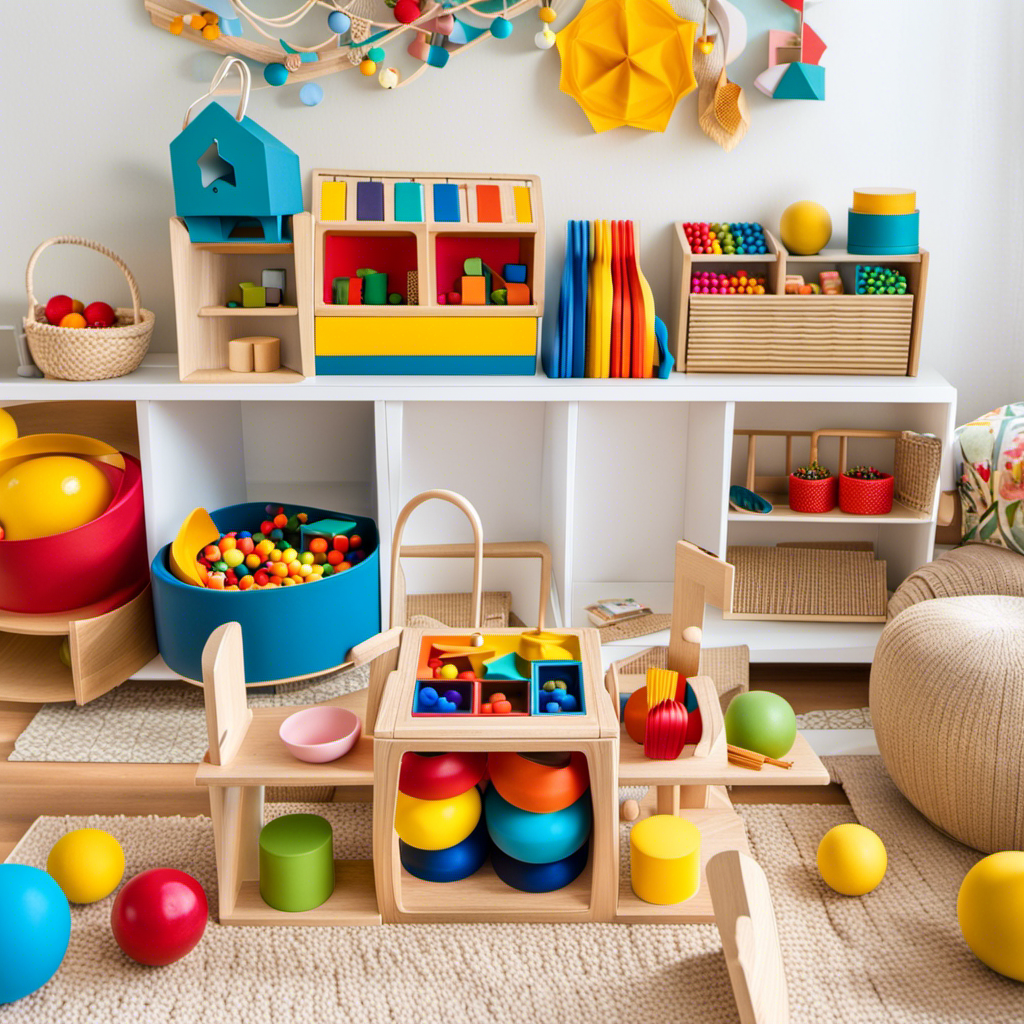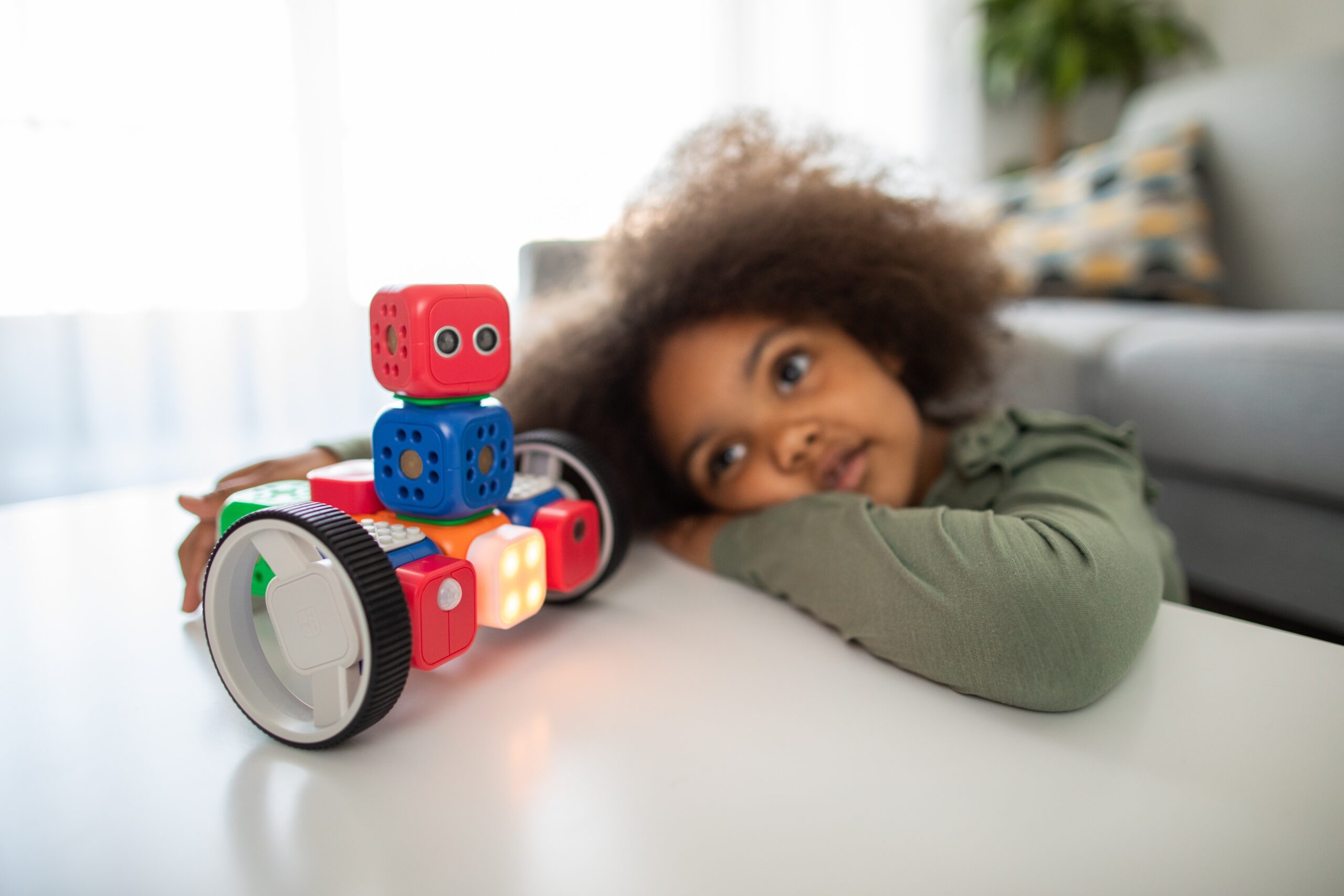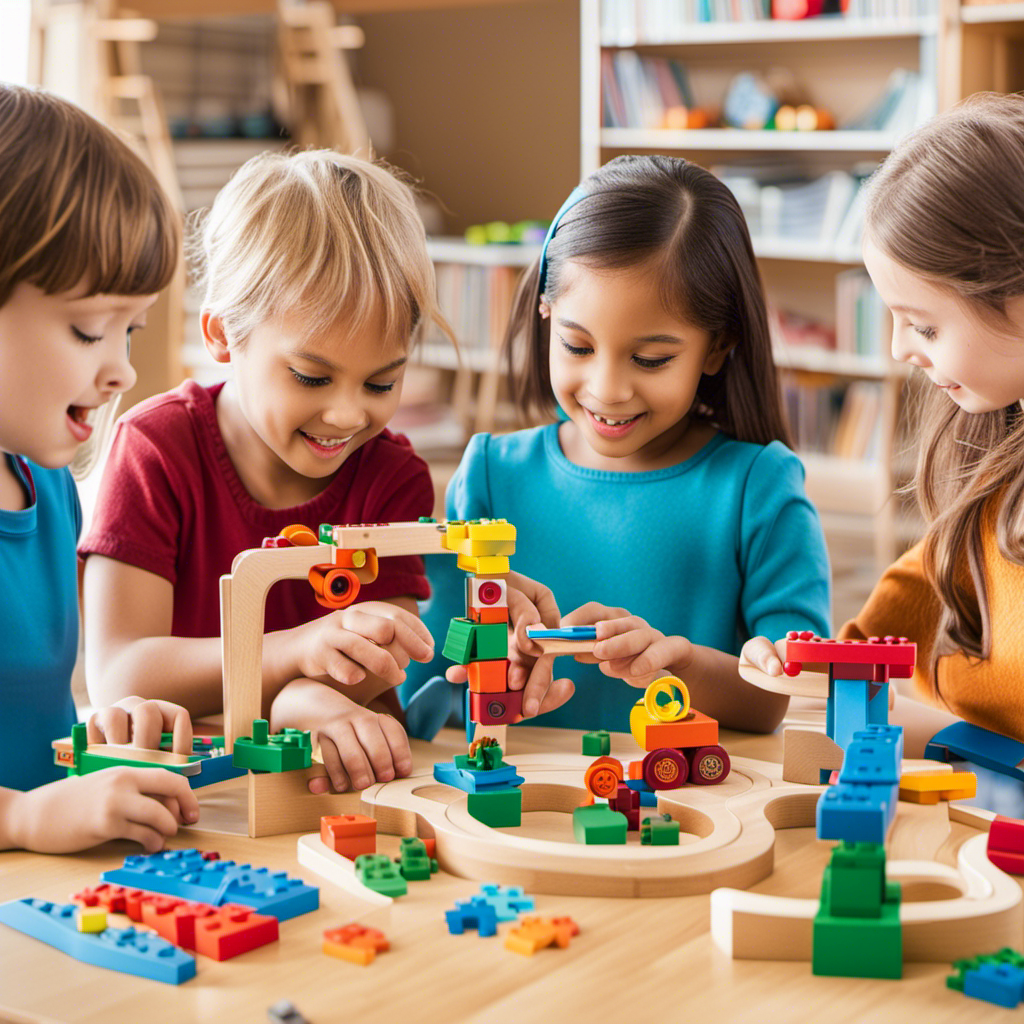Did you know that involving preschoolers in STEM (science, technology, engineering, and math) activities can improve their critical thinking skills and problem-solving abilities?
In this article, I’ll show you how to create your own STEM toys for your little ones, using materials you already have at home.
From exploring simple machines to building with recyclable materials, we’ll dive into the fascinating world of STEM education for preschoolers.
Get ready to have fun and learn together!
Key Takeaways
- STEM activities develop critical thinking skills and problem-solving abilities.
- Safe material choices are crucial for preschoolers’ safety.
- Making your own STEM toys is a budget-friendly alternative.
- DIY art projects promote imaginative play and important skills.
Understanding the Importance of STEM Education for Preschoolers
You’ll quickly realize the importance of STEM education for preschoolers when you see how it fosters critical thinking and problem-solving skills. Early learning is crucial for a child’s development, and introducing STEM concepts from a young age can have long-lasting benefits. By engaging in hands-on activities, preschoolers can explore and experiment, building a strong foundation for their future learning.
STEM education encourages children to think creatively and analytically. It challenges them to ask questions, make predictions, and find solutions. Through activities like building structures with blocks or conducting simple science experiments, preschoolers learn to observe, think critically, and problem-solve. These skills are essential not only for academic success but also for everyday life.
Hands-on activities have numerous benefits for preschoolers. They allow children to engage their senses, promoting a deeper understanding of concepts. When children can touch, see, and manipulate objects, they develop a stronger connection to the subject matter. This active involvement enhances their learning experience and increases their motivation to explore further.
Understanding the importance of early learning and the benefits of hands-on activities sets the stage for creating DIY STEM toys for preschoolers. By choosing the right materials, parents and educators can provide engaging and educational experiences that will capture the imagination of young learners.
Choosing the Right Materials for DIY STEM Toys
When it comes to creating DIY STEM toys for preschoolers, two important factors to consider are safe material choices and budget-friendly options.
As a parent, I want to make sure that the materials I use are safe for my child to play with and explore. Additionally, finding budget-friendly options allows me to provide engaging and educational toys without breaking the bank.
In this discussion, I will explore different safe material choices and budget-friendly options for creating DIY STEM toys that will keep your little ones entertained and learning.
Safe Material Choices
To ensure the safety of your preschooler, it’s important to choose materials that are non-toxic and free from small parts. Here are some safe material choices for eco-friendly options and sensory play ideas:
- Natural materials: Opt for toys made from wood, bamboo, or organic cotton. These materials are non-toxic and sustainable.
- Recycled materials: Look for toys made from recycled plastic or paper. Not only are they safe for your child, but they also help reduce waste and promote environmental sustainability.
- Water-based paints: When painting or coloring toys, use water-based paints that are free from harmful chemicals. This way, your child can explore colors and textures without any health risks.
- Soft fabrics: Choose toys made from soft fabrics like fleece or felt. They are gentle on your child’s skin and provide a sensory experience through touch.
By selecting these safe materials, you can create engaging and eco-friendly toys for your preschooler’s sensory play.
Now, let’s explore some budget-friendly options for DIY STEM toys.
Budget-Friendly Options
Looking for affordable options? Consider checking out second-hand stores and online marketplaces for gently used toys that are budget-friendly. You’d be surprised at the great deals you can find!
Another option is to make your own STEM toys. Not only is it a budget-friendly alternative, but it also allows you to customize toys according to your child’s interests and learning needs. There are plenty of DIY STEM toy tutorials available online that provide step-by-step instructions for making toys like building blocks, magnetic mazes, and even simple robots.
By making your own toys, you can save money and have fun at the same time.
Now, let’s explore simple machines with homemade toys and see how they can teach your little ones about engineering and problem-solving skills.
Exploring Simple Machines With Homemade Toys
You can explore simple machines with homemade toys and spark your preschooler’s curiosity. Simple machines are tools that make work easier, and one type of simple machine is an inclined plane.
An inclined plane is a flat surface that is angled, like a ramp. It helps to move objects from a lower height to a higher height or vice versa. To introduce this concept to your little one, you can create a toy ramp using materials you already have at home. Find a sturdy board or a piece of cardboard and prop it up on books or blocks to create an inclined plane. Then, encourage your preschooler to roll different objects, like toy cars or balls, down the ramp. As they observe the objects rolling down, they will start to understand how the inclined plane helps to move things.
This activity not only teaches them about simple machines but also allows them to explore forces and motion in a hands-on way.
By exploring simple machines with homemade toys, your child will develop an understanding of how different objects and forces interact. They will begin to see how inclined planes can make tasks easier and how the angle of the ramp affects the movement of objects.
Building and engineering with recyclable materials takes this exploration to the next level, allowing your preschooler to get creative and build their own simple machines using items like cardboard tubes, bottle caps, and empty boxes.
Building and Engineering With Recyclable Materials
Building and engineering with recyclable materials allows children to get creative and build their own simple machines using items like cardboard tubes, bottle caps, and empty boxes. It’s amazing what you can create with just a few household items! Here are some ideas to get you started:
- Cardboard Tube Marble Run: Take a cardboard tube and cut it in half lengthwise. Attach the two halves to a flat surface, like a wall or a piece of cardboard, using tape or glue. Then, use more tubes to create ramps and tunnels for the marbles to roll through. It’s like having your very own amusement park!
- Bottle Cap Castanets: Collect a bunch of bottle caps and glue them to popsicle sticks. Decorate them with paint or stickers, and you’ve got your own musical instruments. Tap them together to make fun sounds and create your own rhythms.
- Empty Box Puppet Theater: Take an empty box and cut out a rectangular hole in the front. Decorate the box with paint or markers to make it look like a stage. Then, use paper bags or socks to create puppets. Put on a show and let your imagination run wild!
- Cardboard Box Car: Find a large cardboard box and cut out a hole for the windshield. Decorate the box to look like a car, using markers or paint. Attach paper plates or plastic lids as wheels. Now you’re ready to take your DIY car for a spin!
- DIY Binoculars: Take two empty toilet paper rolls and decorate them with stickers or markers. Attach them together with tape or glue, and now you have your very own binoculars. Use them to go on a backyard safari or explore the world around you.
Building and engineering with recyclable materials is not only fun, but it also teaches children about creativity, problem-solving, and resourcefulness.
Now, let’s explore the wonders of magnetism through DIY toys!
Exploring the Wonders of Magnetism Through DIY Toys
Exploring the wonders of magnetism through DIY toys can be a fascinating and educational experience for children of all ages. Magnetism is a mysterious force that can attract or repel objects without even touching them. By conducting magnetism experiments and playing magnetic games, children can learn about this intriguing phenomenon while having a blast.
One simple DIY toy that showcases magnetism is the magnetic fishing game. All you need is a small magnetic rod, some paper clips, and a container filled with water and plastic fish. Attach the paper clips to the fish and let your little ones use the magnetic rod to ‘fish’ them out of the water. They will be amazed at how the magnet attracts the paper clips and brings the fish to the surface.
Another fun activity is creating a magnetic maze. Draw a maze on a piece of paper and place a small magnet underneath it. Using another magnet on top of the paper, children can guide a metal ball through the maze by manipulating the magnet beneath. This not only teaches them about magnetism but also enhances their problem-solving skills as they figure out the best way to navigate the maze.
Emphasizing Problem-Solving Skills With Puzzles and Brain Teasers
Hey there! Let’s dive into the exciting world of problem-solving and discover all the incredible benefits it brings.
Engaging young minds in puzzles and brain teasers not only sparks their curiosity, but also helps them develop critical thinking skills that will be invaluable throughout their lives.
By solving problems, children gain confidence, improve their decision-making abilities, and learn to think outside the box.
Benefits of Problem-Solving
To enhance your child’s critical thinking skills, you can encourage them to solve puzzles and engage in problem-solving activities. These activities not only improve cognitive skills but also foster innovation and creativity.
By solving puzzles, children learn to think critically and analyze different options to find the best solution. This helps them develop their problem-solving abilities and strengthens their logical reasoning skills.
Moreover, problem-solving activities encourage children to think outside the box and come up with unique solutions, which enhances their creativity and innovative thinking. By engaging in such activities, children learn to approach challenges with a positive mindset and develop resilience.
These skills will benefit them in various aspects of life, such as academics, social interactions, and future careers.
As we move on to engaging young minds, we can explore more ways to stimulate their curiosity and develop their STEM skills.
Engaging Young Minds
Are you looking for fun and interactive ways to engage young minds? As a parent or educator, it’s important to provide engaging activities that promote interactive learning.
One fantastic way to accomplish this is by creating your own STEM toys for preschoolers. By incorporating hands-on activities, children are actively involved in the learning process, which enhances their understanding and retention of concepts.
When designing STEM toys, consider activities that encourage children to explore, problem solve, and think critically. For example, building blocks can be used to construct towers, encouraging children to experiment with balance and stability. Magnetic puzzles can promote problem-solving skills, as children figure out how to connect the pieces.
Enhancing Critical Thinking
When enhancing critical thinking skills in preschoolers, it’s important to provide opportunities for problem-solving and creative thinking. By engaging them in activities that require problem solving strategies, we can help foster their cognitive development. Here are some simple problem solving activities that you can try with your little ones:
| Problem | Solution |
|---|---|
| How to build a tower using blocks? | Experiment with different block arrangements and sizes. |
| How to sort objects by color? | Encourage them to group objects based on their colors. |
| How to complete a puzzle? | Break it down into smaller parts and work on one section at a time. |
| How to make a ramp for a toy car? | Use household items like books and cardboard to create a ramp. |
| How to make a shape using playdough? | Teach them how to mold and shape the playdough into different forms. |
Sparking Creativity and Imagination With DIY Artistic STEM Toys
Get ready to ignite your preschooler’s creativity and imagination with these DIY artistic STEM toys. DIY art projects are not only a great way to keep your little ones entertained, but they also promote imaginative play and help develop important skills.
One fantastic DIY art project is creating a homemade easel. All you need is a sturdy piece of cardboard, some clothespins, and a few paintbrushes. Your child can use their imagination to paint colorful masterpieces and display them proudly on their homemade easel. This activity encourages creativity and helps improve fine motor skills.
Another fun DIY art project is making your own playdough. Not only is it simple to make with common household ingredients, but it also provides endless opportunities for creative play. Your preschooler can use their playdough to sculpt animals, shapes, or even their favorite characters from storybooks. This activity allows them to express their creativity and practice their hand-eye coordination.
By engaging in these DIY art projects, your preschooler can develop their creativity, imagination, and fine motor skills. Now, let’s explore how to introduce coding concepts through interactive DIY toys.
Transition: Now that we’ve sparked your child’s creativity and imagination, let’s take their learning to the next level by introducing coding concepts through interactive DIY toys.
Introducing Coding Concepts Through Interactive DIY Toys
Hey there! Let’s talk about an exciting topic: coding!
Did you know that you can learn coding through fun hands-on activities? It’s true! By engaging in early STEM education and exploring DIY learning opportunities, you can start building your coding skills right from the start.
So get ready to dive into the world of coding with interactive toys that will make learning an absolute blast!
Hands-On Coding Activities
To create hands-on coding activities for preschoolers, you can start by using simple materials like blocks and stickers. Here are three fun and interactive coding games that you can try with your little ones:
- Pattern Play: Create a pattern with blocks and stickers, and encourage your child to replicate it. This game helps them understand sequencing and logical thinking.
- Obstacle Course: Set up a maze using blocks and stickers, and ask your child to guide a toy car through it. They will learn about problem-solving and spatial awareness.
- Robot Dance: Create a dance routine using stickers on the floor and instruct your child to follow the steps. This activity promotes creativity and computational thinking.
Early STEM Education
After exploring hands-on coding activities, let’s dive into the world of early STEM education. As a parent or educator, it’s important to lay a strong foundation for young learners by introducing them to STEM concepts at an early age. By incorporating hands-on learning activities, children can develop critical thinking skills while having fun. Here is a table highlighting some engaging and age-appropriate early STEM curriculum activities:
| Activity | Description |
|---|---|
| Building Blocks | Encourage children to build structures using blocks, fostering creativity and spatial awareness. |
| Nature Scavenger Hunt | Take children on a nature walk and ask them to find different types of leaves, rocks, or insects, promoting observation and classification skills. |
| Sink or Float Experiment | Fill a tub with water and various objects for children to test if they sink or float, teaching them about density and buoyancy. |
| Simple Machines | Introduce children to simple machines like levers and pulleys through hands-on projects, sparking their curiosity about how things work. |
| Gardening | Involve children in planting and caring for a garden, teaching them about biology and the importance of sustainability. |
Now that we have explored early STEM education, let’s move on to DIY learning opportunities that you can create at home or in the classroom.
DIY Learning Opportunities
Now that we’ve covered early STEM education, let’s explore some DIY learning opportunities that can be easily created at home or in the classroom. Here are some ideas to get you started:
- Sensory Bottles: Fill empty plastic bottles with water, glitter, and small objects to create mesmerizing sensory bottles that promote visual tracking and calmness.
- Playdough Exploration: Make your own playdough using flour, salt, water, and food coloring. Encourage your child to shape and mold the playdough, enhancing their fine motor skills and creativity.
- Nature Scavenger Hunt: Head outdoors and create a list of natural items for your child to find, such as leaves, rocks, and flowers. This activity promotes observation skills and a connection to the natural world.
- Building with Recyclables: Collect empty cardboard boxes, tubes, and containers. Let your child’s imagination run wild as they construct and engineer their own creations.
- Kitchen Science: Use everyday ingredients like vinegar, baking soda, and food coloring to conduct simple experiments that introduce basic scientific concepts.
By engaging in these DIY sensory play and hands-on learning activities, children can enhance their fine motor skills and develop a love for STEM exploration.
Now, let’s dive into enhancing fine motor skills with hands-on STEM toys.
Enhancing Fine Motor Skills With Hands-On STEM Toys
Using hands-on STEM toys is a great way to enhance fine motor skills in preschoolers. Not only are these toys a fun and engaging way to play, but they also provide numerous benefits for young minds. When choosing STEM toys, it’s important to consider budget-friendly options that will still captivate and challenge your child’s imagination.
There are many budget-friendly options available that can help your child develop their fine motor skills. Building blocks, for example, allow children to practice grasping and manipulating objects, while also encouraging creativity and problem-solving. Puzzle sets are another great choice, as they require children to use their hands to fit the pieces together. Additionally, construction sets like magnetic tiles or interlocking gears provide endless opportunities for hands-on exploration and fine motor skill development.
Exploring the World of Science Through DIY Experiments
When it comes to learning, I firmly believe that hands-on experiences are the best way to go. Not only do they provide a fun and engaging learning environment, but they also have numerous benefits for children.
From improving fine motor skills to fostering creative problem-solving skills, hands-on learning allows children to explore and discover the world around them in a meaningful way.
Hands-On Learning Benefits
Hands-on learning has numerous benefits for preschoolers. It not only helps them develop important skills, but also promotes early STEM education. Here are four reasons why hands-on learning is so beneficial for young children:
- Active engagement: When children actively participate in activities, they are more engaged and motivated to learn. Hands-on learning allows them to touch, feel, and manipulate objects, which enhances their understanding and retention of concepts.
- Development of fine motor skills: Hands-on activities like building blocks or playing with clay help children develop their fine motor skills, which are essential for tasks like writing and tying shoelaces.
- Critical thinking skills: By exploring and experimenting, children learn to think critically and solve problems. They develop their ability to analyze, predict, and make connections between different elements.
- Social and emotional development: Hands-on learning often involves collaboration and teamwork, which helps children develop important social skills like sharing, taking turns, and communicating effectively.
Creative Problem-Solving Skills
As we discussed earlier, hands-on learning has numerous benefits for preschoolers. But did you know that it also helps develop problem-solving skills and promotes critical thinking?
When children are engaged in creative play and exploration, they are constantly faced with challenges and obstacles that require them to think critically and come up with solutions. Whether it’s building a tower with blocks or figuring out how to fit puzzle pieces together, these activities encourage children to use their problem-solving abilities.
By allowing children to experiment and make mistakes, we are teaching them that it’s okay to try different approaches and learn from their failures. This helps them develop resilience and perseverance, important traits for problem-solving.
So, when we make our own STEM toys for preschoolers, we are not only promoting creativity and hands-on learning, but also fostering their problem-solving skills and critical thinking abilities.
Now, let’s explore another exciting aspect of DIY STEM toys: understanding math concepts with DIY manipulatives…
Understanding Math Concepts With DIY Manipulatives
You can reinforce math concepts with DIY manipulatives that you make yourself. DIY math manipulatives are a great way to make math fun and engaging for preschoolers. By using hands-on math activities, you can help children develop a strong foundation in math skills while also fostering their creativity and problem-solving abilities.
One of my favorite DIY math manipulatives is the counting jar. To make a counting jar, simply clean and dry an empty plastic container, like a peanut butter jar. Then, fill it with small objects such as buttons, beads, or even cereal. Encourage your child to count the objects and practice basic math operations like addition and subtraction.
Another fun idea is to create number cards using index cards or construction paper. Write numbers on the cards and have your child match them with the corresponding number of objects. This activity helps children recognize numbers and understand their value.
By incorporating DIY math manipulatives into your child’s learning routine, you not only make math more enjoyable, but you also provide them with hands-on experiences that enhance their understanding of mathematical concepts.
Now, let’s move on to the next section and explore how we can encourage critical thinking with DIY logic games.
Encouraging Critical Thinking With DIY Logic Games
Now, let’s explore how you can encourage critical thinking by creating your own logic games. DIY logic puzzles are a great way to challenge your preschooler’s problem-solving skills while having fun.
To start, gather materials such as cardboard, markers, and scissors. Cut the cardboard into squares or shapes to create puzzle pieces. On each piece, draw a simple picture or symbol. Make sure to create a set of puzzle pieces that fit together in a specific pattern or sequence. For example, you can create a puzzle where the pieces form a flower when assembled correctly.
Next, mix up the puzzle pieces and challenge your child to put them back together to recreate the original image. As they manipulate the pieces and try different combinations, they will develop their critical thinking skills by analyzing patterns, making logical connections, and testing hypotheses.
By engaging in DIY logic games, your child will learn to think critically and creatively, improving their problem-solving abilities. These games foster a sense of curiosity and encourage children to explore different approaches to reach a solution. As they tackle these challenges, they will develop skills such as logical reasoning, spatial awareness, and attention to detail. These abilities are essential for future success in fields such as mathematics, science, and engineering.
Now, let’s dive into exploring engineering principles with DIY structures and bridges.
Exploring Engineering Principles With DIY Structures and Bridges
Now that we’ve had fun with logic games, let’s dive into the world of engineering principles! In this section, we’ll be exploring architectural design with DIY structures and understanding structural stability with homemade bridges.
Building structures and bridges can be a thrilling way to introduce your preschooler to the wonders of engineering. Not only will they learn about balance, stability, and problem-solving, but they’ll also get to unleash their creativity and imagination.
To get started, gather some materials like popsicle sticks, cardboard, tape, and glue. Then, let your little engineer’s imagination run wild! Encourage them to experiment with different shapes and sizes, and see how they can create their own unique structures.
To help you and your preschooler get inspired, I’ve created a table below showcasing a few ideas for DIY structures and bridges:
| Structure | Materials Needed | Purpose |
|---|---|---|
| Tower | Popsicle sticks | Learn about height |
| Bridge | Cardboard | Understand weight-bearing |
| House | Paper cups | Explore symmetry |
| Tunnel | Cardboard tubes | Discover different shapes |
| Arch | Craft sticks | Learn about stability |
By exploring architectural design and understanding structural stability with homemade structures and bridges, your preschooler will develop essential skills in problem-solving, critical thinking, and creativity. So, let’s get building and watch their engineering skills blossom!
Now, let’s move on to the next section, where we’ll be developing spatial awareness through DIY 3D puzzles.
Developing Spatial Awareness Through DIY 3D Puzzles
Let’s explore spatial awareness by creating our own DIY 3D puzzles! Developing problem-solving skills and enhancing spatial reasoning are important for young children’s cognitive development. DIY 3D puzzles are a great way to engage preschoolers in a hands-on activity that challenges their thinking and promotes spatial awareness.
To make your own DIY 3D puzzles, you can start by gathering materials like cardboard, markers, scissors, and glue. Draw different shapes on the cardboard and cut them out to create puzzle pieces. You can make simple shapes like squares, triangles, and circles, or more complex ones like animals or vehicles.
Once you have your puzzle pieces ready, it’s time to assemble them into 3D structures. Encourage your child to use their problem-solving skills to figure out how the pieces fit together. This activity not only promotes spatial awareness but also helps children develop their fine motor skills and hand-eye coordination.
By engaging in DIY 3D puzzles, children can improve their ability to visualize and manipulate objects in space. These skills are important for tasks like reading maps, understanding concepts of distance and size, and even solving complex mathematical problems.
As children develop their spatial awareness through DIY 3D puzzles, they are also preparing themselves for future STEM learning. The ability to think spatially is crucial in fields like engineering, architecture, and computer science.
Now, let’s transition to the next section where we will explore how DIY group STEM activities can foster collaboration and teamwork.
Fostering Collaboration and Teamwork With DIY Group STEM Activities
Working together on DIY group STEM activities can foster collaboration and teamwork among children. It’s amazing to see how children can come together, share ideas, and work towards a common goal. Here are some exciting ways that collaborative STEM activities can promote collaboration and teamwork:
- Creating a marble run: Children can work in small groups to design and build a marble run using materials like cardboard tubes, popsicle sticks, and tape. Each child can contribute their own ideas and skills to build a unique and functional marble run.
- Building a bridge: By working together to construct a bridge using toothpicks and clay, children can learn to communicate and problem-solve as they figure out the best way to make their bridge strong and stable.
- Designing a boat: Children can work in teams to design and build a boat using materials like foil, straws, and paper. They will need to collaborate to come up with a design that floats and moves smoothly in water.
- Constructing a tower: Using materials like cups, index cards, and tape, children can work together to build the tallest tower possible. They will need to communicate and coordinate their efforts to ensure stability and balance.
- Solving a STEM challenge: Collaborative STEM challenges, like building a paper airplane that can fly the farthest or creating a contraption to protect an egg from a fall, can encourage children to work together to find creative solutions.
Through these open-ended STEM projects, children can foster their creativity, promote communication skills, and learn the value of teamwork and collaboration.
Frequently Asked Questions
Are There Any Safety Precautions to Consider When Making DIY STEM Toys for Preschoolers?
When making DIY STEM toys for preschoolers, it’s crucial to consider safety precautions. Always use age appropriate materials to ensure they are safe for little ones. Certain small parts or sharp edges can pose a choking hazard, so be mindful of that.
It’s also important to supervise children while they play with these toys to prevent any accidents. By taking these precautions, you can create engaging and educational STEM toys that are safe for preschoolers to enjoy.
How Can I Adapt the DIY STEM Toys for Children With Special Needs?
When it comes to adapting DIY STEM toys for children with special needs, there are a few ideas that can make playtime more inclusive and enjoyable.
First, consider modifying the toys to be more sensory-friendly, such as adding different textures or sounds.
Additionally, you can make the toys more accessible by incorporating larger buttons or switches for children with motor disabilities.
It’s important to remember that each child is unique, so always consider their individual needs when modifying DIY toys for kids with disabilities.
Can You Provide Some Examples of Simple Machines That Can Be Explored Through Homemade Toys?
Sure, I can provide some examples of simple machines that can be explored through homemade toys.
Exploring pulleys, levers, and inclined planes can be a fun and educational experience for preschoolers. These simple machines can be incorporated into DIY STEM toys to teach children about basic principles of physics and engineering.
Are There Any Specific Recyclable Materials That Work Best for Building and Engineering DIY Toys?
Recyclable materials for building DIY STEM toys can be found all around us. Things like cardboard, plastic bottles, and empty containers can be transformed into amazing toys that promote engineering and problem-solving skills.
When it comes to sensory play, recyclable materials like rice, dried beans, and fabric scraps can create fun and engaging textures for little ones to explore.
How Can I Incorporate Coding Concepts Into Interactive DIY Toys for Preschoolers?
Incorporating coding concepts into interactive DIY toys for preschoolers can be a fun and educational way to introduce them to the world of technology. By using programmable blocks or creating a simple coding game, children can learn basic coding principles like sequencing and problem-solving.
It’s important to make sure the activities are age-appropriate and engaging to keep their interest. By doing this, we can ignite their curiosity and set them on a path to becoming future coders and innovators.
Conclusion
Creating your own STEM toys for preschoolers is a rewarding and engaging way to introduce them to the wonders of science, technology, engineering, and math. By using everyday materials and a little bit of creativity, you can provide endless opportunities for learning and exploration.
From exploring simple machines to building with recyclable materials, the possibilities are endless. So grab your tools and let your imagination run wild as you embark on this exciting journey of hands-on learning with your little ones.
Get ready for a world of discovery and endless fun!









